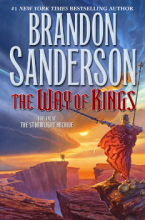The Stormlight Archives - Brandon Sanderson

The Way of Kings is the first book in the 10 book Stormlight Archive. And what an introduction!
Roshar, the world of the Stormlight Archive, was plagued by a long series of apocolyptic desolations that stunted human progress for a long time. The Way of Kings takes place several millenia after the desolations have stopped and a wide array of civilizations have fluorished. In this world, storms constantly rack the continent to the extent that there is no dirt on the ground and that the plants know how to retreat into cracks in the stone when a storm is coming. These storms also charge gems with stormlight, making them glow for days. The spirits of various ideas are a part of the world called spren, so you can see windspren in the wind or rotspren on a festering wound.
One of the things that I like best about the Stormlight Archive is how multicultural it is. The protagonists are mainly from one culture, but there are vignettes featuring many other characters from different walks of life, and the protagonists interact with people of other cultures. Much of the book involves showing different perspectives on a given bit of culture, which has the effect of making apparent how socially constructed it is. For instance, in the Alethi culture, women cover one of their hands (their "safe hand") because it is seen as erotic, and Sanderson uses that as an inroad to talk about taboos. There is also a lot of discussion about people's role in society. For instance, the Alethi have castes based on eye color, where people with light colored eyes are upper class and people with dark colored eyes are lower class. Also, most men are illiterate, so the intellectuals, engineers, etc, are mostly women. Many books have interesting cultural explorations, but The Stormlight Archive is one of the best at exploring dozens and dozens of cultures in an interesting way.
While the protagonists are mostly from the same culture, they each have interesting and very different histories. Each book goes into the history of one of the characters in addition to the present day events. Sanderson does a very good job with this, and the past events give the reader insight into the present-day conflicts such that it all feels like one story.
I also appreciated Sanderson's treatment of atheism. Sanderson is religious, as are most of his characters are, but he has one strong atheist, and he portrays her well, in addition to throwing in a bit of a humanist and a storyteller.
The discussion of violence in the book is also interesting. The general weary of military adventurism and the soldier who was meant to be a surgeon know the ways of war, but they are reluctant to fight. Their culture says that there is glory in war, it is their job, and they have plenty of reasons why fighting would be an attractive option, but the book presents many compelling defenses of nonviolence and many condemnadions of the ways violence is waged.
Overall, I'm very happy with this series, and I look forward to continuing it, though it might be a couple of decades before it's done!



